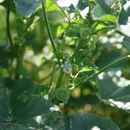Distribution in Egypt
provided by Bibliotheca Alexandrina LifeDesk
- author
- BA Cultnat
- provider
- Bibliotheca Alexandrina
Global Distribution
provided by Bibliotheca Alexandrina LifeDesk
Europe, north Africa, west Asia.
- author
- BA Cultnat
- provider
- Bibliotheca Alexandrina
Associations
provided by BioImages, the virtual fieldguide, UK
Foodplant / internal feeder
larva of Apion radiolus feeds within stem of Malva neglecta
Foodplant / internal feeder
larva of Apion rufirostre feeds within fruit of Malva neglecta
Foodplant / gall
pulvinate telium of Puccinia malvacearum causes gall of live stem of Malva neglecta
Remarks: season: 4-11
Description
provided by eFloras
Prostrate or decumbent, perennial, basally woody herb. Branches stellate pubescent, densely so on young parts. Leaves orbicular, deeply cordate at base, 1-3 (-4) cm long, 1-4(-6) cm broad, simple-stellate hairy above, stellate below, crenate, occasionally shallowly 5-lobed;stipules ovate-lanceolate,c.5mm long, c. 2 mm broad, scarious, margin ciliate; petiole 3-12 (-25) cm long, stellate; pubescent, dense so above, glabrescent below. Flowers axillary, generally 3 on 4 in fascicles, occasionally solitary, particularly on the lower branches; pedicel (0.5-) 1-3 cm long, stellate pubescent. Epicalyx segments linear to linear-lanceolate, stellate pubescent, 3-4 mm long, c.l mm broad. Calyx free to the middle, 5-8 mm long, stellate pubescent; lobes 3-5 mm broad, deltoid or triangular. Petals 10-13 mm long, 3-4 mm broad, oblong-obovate, retuse, claw hairy on the margin, purplish or pinkish. Stamina] column 5-7 mm long, pubescent. Fruit depressed, 5-6 mm across; mericarps 13-15, pubescent, smooth margin usually rounded, 1.5-2 mm across in all directions. Seed dark brown, pubescent, reniform, 1 mm long and broad.
- license
- cc-by-nc-sa-3.0
- copyright
- Missouri Botanical Garden, 4344 Shaw Boulevard, St. Louis, MO, 63110 USA
Distribution
provided by eFloras
Distribution: Worldwide but of Old World origin. Naturalized in America. In Pakistan it widely occurs from plains to 14000 ft.
- license
- cc-by-nc-sa-3.0
- copyright
- Missouri Botanical Garden, 4344 Shaw Boulevard, St. Louis, MO, 63110 USA
Derivation of specific name
provided by Flora of Zimbabwe
neglecta: overlooked
- license
- cc-by-nc
- copyright
- Mark Hyde, Bart Wursten and Petra Ballings
- bibliographic citation
- Hyde, M.A., Wursten, B.T. and Ballings, P. (2002-2014). Malva neglecta Wallr. Flora of Zimbabwe website. Accessed 28 August 2014 at http://www.zimbabweflora.co.zw/speciesdata/species.php?species_id=138990
- author
- Mark Hyde
- author
- Bart Wursten
- author
- Petra Ballings
Malva neglecta: Brief Summary
provided by wikipedia EN
Malva neglecta is a species of plant of the family Malvaceae, native to most of the Old World except sub-Saharan Africa. It is an annual growing to 0.6 m (2 ft). It is known as common mallow in the United States and also as buttonweed, cheeseplant, cheeseweed, dwarf mallow, and roundleaf mallow. This plant is often consumed as a food, with its leaves, stalks and seed all being considered edible. This is especially true of the seeds, which contain 21% protein and 15.2% fat.
- license
- cc-by-sa-3.0
- copyright
- Wikipedia authors and editors

